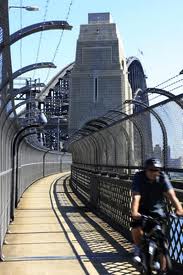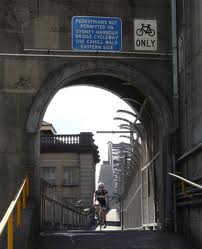Midweek post. Mentioned doing a degree last time in Adventure Recreation, one high point getting to write about time spent in Sydney 1998 in a season as a bike messenger and the way that Risk is dealt with by riders. Good times, this is an extract. comment me for more academic writing if you like.

It was from this context of extended travel abroad that I found myself living in Sydney, Australia and employed as a cycle messenger for a season in 1998. As this situation was unbounded by time constraints or financial necessity I am choosing it as a specific version of adventure recreation, in an attempt to illustrate how identity creation works alongside the social construction of risk. When considered objectively there are few motivators to encourage riders to take on a job where there is no sick or holiday pay, the work places are the streets and offices of a city and where one can expect to earn only 50-60 percent of a $4-$4.50 standard charge of one message or parcel drop. Messengers have no union protecting their interests and have few fringe benefits. Utilising a grid system of one-way streets the messenger has to navigate around, picking up and dropping off parcels on the most expeditious route while at the same time avoiding the real risks that occur, these actual risks translate in different ways to people on an emotional level, but as stamina is built, and experience is accumulated though, the identity creation begins to strengthen. Berated by buses, taxis and car drivers, always conscious of the possibility that a pedestrian may walk out or a car door may open and subject to the immediate effects of pollution, the messenger is assailed on all sides by uncontrollable physical hazards.
This combination of elements seen from a civilian perspective might possibly discourage people from choosing this occupation, and indeed the temporary employment patterns indicate an increasingly transient workforce, yet its’ this engagement with risk that is suggested as a motivator to perform adventurous action,
Simmel (1911,p231) classically wrote “The adventurer is also the extreme example of the a historical individual, the man who lives in the present”.
In this arena, the streets become a leveller for race, class and gender, although this occupation tends to attract mostly young males whose internalisation of images seen throughout literature relating to adventure and exploration, continue the dialectic of media identification. Working in the city there has to be a negotiation of social and cultural risks too, meeting the intensive time demands integral to the job not only means riders get paid but that they are accepted into the informal hierarchy that exists. Belonging to an egalitarian collection of people from many nationalities is part of the shared group identity to which the messengers ascribe, Beck (1992,p98) suggests “They experiment with social relationships, personal life and ones own body in the numerous variants of the alternative and subcultures”.
As we have seen there is a playing out of drama in cycling emphasised by what Jenkins (1996,p70) calls “An emphasis on physicality of co-presence”, the close proximity of others whilst travelling around and in lifts, offices and workplaces in a two way gaze that helps to construct a specific identity. At work consistently on a visible level, a two-way process occurs where individuals create the routines and rituals of social interaction. Even at rest away from work this identity endures through such notions as “Body narratives” (Elsrud, 2001,p609), in this instance peak fitness results in a muscular, toned image of physicality. As there is no uniform other than perhaps a t-shirt advertising the courier company, idiosyncratic forms of self expression occur, some examples of this could be dreadlocks, tattoos and outlandish clothing worn in a way that challenges the mainstream uniforms of the city worker, again here we can see how social construction operates. One messenger described “Deriving my living from something that compared to those all around is a game” (Adam, 1998,p2), this person clearly felt that he was positioning himself outside of the mainstream of society yet we should note that identity creation is a dialectical relationship, without the returning gaze of civilians there can be no separate image. There are some activities in this form of adventure that require definite skill acquisition to complete, as with other sports it is the exercise of these skills that brings rewards. A blend of strategy and speed is essential for the messenger to have any chance of making riding a worthwhile enterprise, we could liken it to the movement of a chess piece across the board, stopping strategically to pick up and drop off parcels with one destination constantly in mind yet never straying far off the closet course possible. Techniques like drafting vehicles, bypassing through the centre of lanes and running red lights alongside environmental conditions like road quality and weather need constant adjustment and anticipation for efficient transit, and a daily basis this “heightened awareness of risk may itself lead to a desire to take risk” (Lupton, 1999,p157). Other potentialities like blind cornering on green lights and sheer speed put this activity into a category distinguished by its risks, like various other adventure sports such as rock-climbing, mountaineering or mountain-biking all of which involve “Courting of danger, the active taking of risks for the excitement and sense of achievement that they bring with them” (Lyng, 1990,p33), lapses in concentration by a messenger can mean disablement or death, its’ this interplay of control and exercise of skill under pressure that leads to pleasurable experience. There is a notion of “Insiders” and “Outsiders” attached to this where “Outsiders raise the question of danger. The insider replies that danger does indeed exist but awareness of it comes only in those passive situations which are the very antithesis of the essentially active sport” (Walter, 1984)
In short then one view sees confronting hazards leading to growth and self-actualisation, existential benefits as there is only the individuals’ subjective knowledge that they played well that day. This says something about the paradox in adventure recreation, that the gains to be made can only be enjoyed by entering into personal involvement with forms of risk.

@2.21 has to be ridden. twice a day at least
